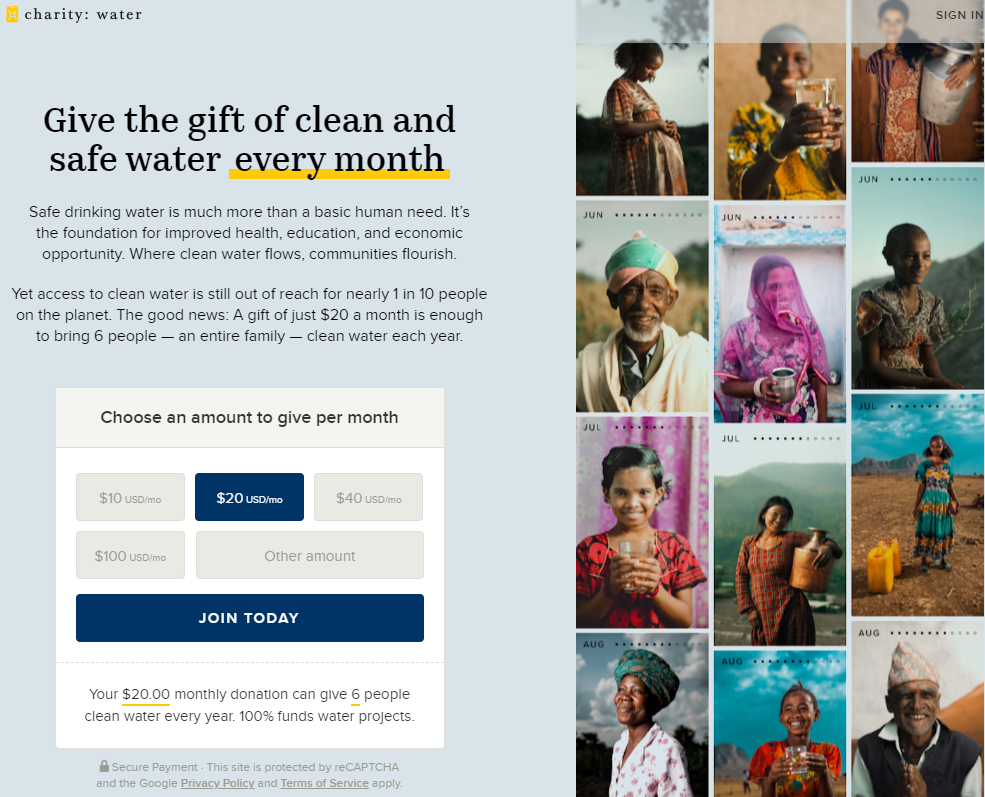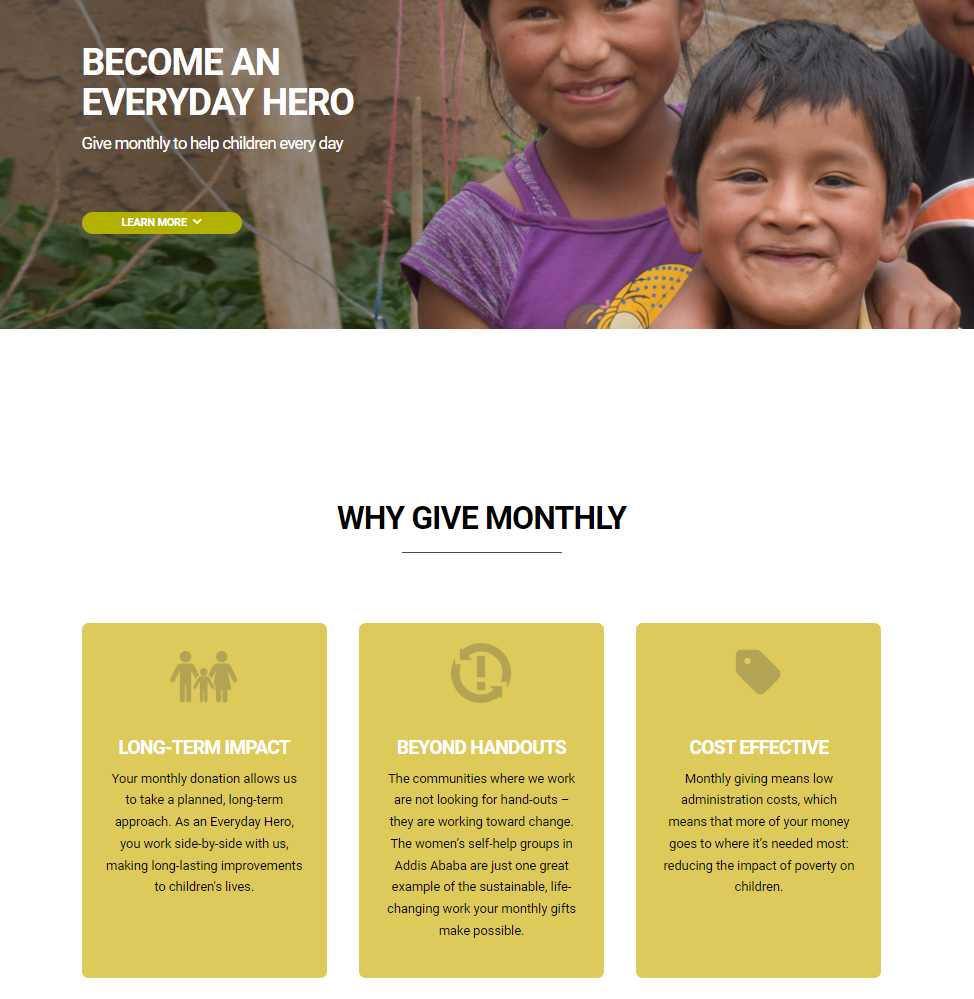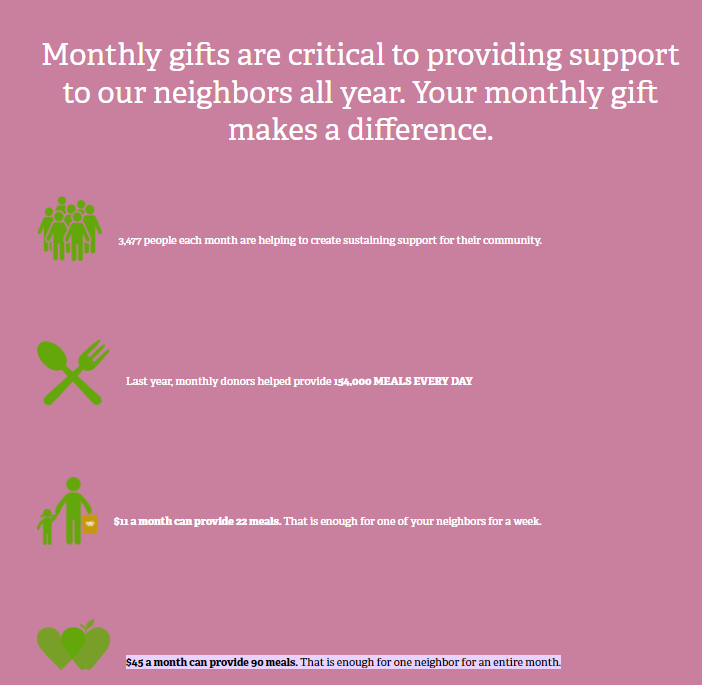 For at least the past seven years I’ve been actively encouraging nonprofits of all stripes to prioritize beginning or ramping up their monthly giving program.
For at least the past seven years I’ve been actively encouraging nonprofits of all stripes to prioritize beginning or ramping up their monthly giving program.
Not a lot of nonprofits were really leaning into this then. But, as much sense as it made then, it makes even more sense now.
So, I’m going to ask you: How are you doing with this?
Here’s why I’m asking.
If there’s anything the pandemic years have taught us,not to mention recent climate-related disasters, you need a dependable source of income in order:
- To be able to sustain programming for problems that never go away.
- To be able to weather current storms, anticipated and unanticipated.
- To be able to reliably plan for the future.
It turns out there’s nothing as dependable as monthly donors.
In fact, donors who give to you recurrently sustain you so well a monthly giving strategy is often called a sustainer program.
Do you deserve a group of people who will sustain you through thick and thin?
Of course you do!
But you don’t always get what you deserve – unless you make it happen.
How to Make Monthly Giving Happen
As someone poetic so eloquently put it:
“Nothing will work unless you do.”
— Maya Angelou
Let’s get down to work!
There are four steps to a successful monthly giving work plan:
First you must decide monthly giving is a priority.
If you’ve ever taken Pilates, you know the importance of strengthening your core.
The same holds true with fundraising strategies.
Monthly giving shouldn’t be just an “add-on” or “nice to have” strategy. You must make it a core part of your annual giving acquisition and retention program.
Find some reasons to persuade your boss or board here and here.
Second, you must put a plan in writing to hold yourself accountable.
The more publicly you commit, the more likely you are to follow through. This is a tried-and-tested principle of psychology and neuroscience, and it works for donors too!
For your written plan you’ll need goals (why you’re doing this), measurable objectives (how you’ll do this), strategies (what you’ll do) and tactics (when and who will do this).
You can grab some strategic suggestions for your building your monthly giving plan here and here.
Third, you must promote your program.
It’s imperative to make it clear, from the donor perspective, why giving this way is super easy and a win/win/win – for the donor, your organization, and the community who relies on you for dependable support.
You can see some great examples here:



Fourth, you must consistently steward your monthly donors.
Your objective is to assure these sustainers feel good enough to continue – and even increase – their giving.
Don’t make the mistake of thanking them only when they make the original commitment.
Send them a brief, monthly story or quick snapshot of someone/something their gift made possible. You’ve got a built-in reason to communicate with them on a regular basis; take advantage of it!
Vida Joven is an organization that does a beautiful job of this. I’ve been giving to them regularly for some time now, and the appealing, heart-warming photos and stories they send make it hard for me to believe I’ll ever stop! Here aret wo monthly examples:
- April

- March

Why Now is the Time to Supercharge Monthly Giving
In a webinar with Deb Ashmore, Blackbaud Principal Analytics consultant, I learned sustainer donors have been growing by leaps and bounds over the past seven years or so – even before the pandemic years when recurring giving was at a peak. And this is true across most sectors (with the exception of animal welfare). [You can find some of the key takeaways here.]
Monthly donors are trending across almost all sectors
Here is some relevant data:
- From 2018 to 2022, the average nonprofit grew its recurring donor base by 127%.
- 57% of donors are enrolled in a recurring giving program, up from 46% the previous year.
- 67% of charities saw an increase in the number of donors giving monthly.
- 78% of charities saw an increase in the number of dollars contributed annually by recurring donors.
- Across nonprofits of all sizes, the average donor lifetime for recurring supporters was just over eight years (8.08 years, to be exact). The average lifetime for non-recurring donors was 1.73 years.
- While revenue from one-time online giving decreased by 12% in 2022, revenue from monthly giving increased by 11% and accounted for 28% of all online giving.
Prioritize one-time donation conversions to monthly
Ashmore noted 2020 was the conversion peak at 12%; it was 11% in 2021. Ashton found this promising, because historically crisis donors have not generally converted, or come on, as monthly. This differs for larger organization with 20,000+ donors vs. small to medium-sized charities. My hunch is the larger organizations see greater success because they consciously build a plan and devlote more resources to developing and sustaining monthly donors. There is NO reason you can’t take this lesson to heart! Meanwhile…
- For large charities, two-thirds of all sustainer donors begin that way.
- For small to medium charities, monthly donor programs rely more on conversions.
In years with plenty of reactionary giving, like 2017 to 2021 (and presumably in the current election year), there are a lot of donors to convert.
What will you do to assure you don’t waste your new donors?
Just as a reminder why you need to ponder this question, here are a few data points:
- From 2020 to 2021 conversion to monthly giving increased from 31% to 38%
- 2017 to 2018 conversion to monthly giving increased from 31% to 35%
- 61% of nonprofits saw an increase in conversions from 2020 to 2021
- Digital efforts account for the largest share of growth, with most growth in email and digital asks
- Conversion generally happens within the first 30 days of acquisition. Generally the ask is built into a new donor welcome letter or email.
- For online donors, donor retention is now slightly easier to maintain as donors warm to monthly recurring donation options.
Monthly Donor Long-Term Donor Value is Increasing
Per Blackbaud, sustaining donors provide a steady revenue stream and outperform one-time or annual givers by as much as 600–800% over their lifetimes. While new donor retention rates average less than 20%, monthly giving programs typically have retention rates of more than 80% after the first year and over 95% after year five. Ultimately, you’ll get a better return on your donor acquisition investment if you can encourage more one-time donors to become recurring donors. Research by Blackbaud, Bonterra and the Fundraising Effectiveness Project all found those making sustainer gifts for three years or more have retention rates upwards of 90%! Note that with single-gift, ongoing (not first-time) donors, retention is still hovering around just 65%. So you can see converting folks to monthly can have a big positive hit on the ultimate long-term value of your overall database.
According to Classy’s “State of Modern Philanthropy” report, recurring donors have the highest lifetime financial return — 42% above fundraising events and 440% above one-time donors! Plus, according to Bloomerang, recurring donors are 6x more likely to consider you in their estate planning.
What’s Next?
It’s clear early investments in sustainers helps you weather uncertainty. Organizations with existing strong monthly giving programs weathered the past decade well.
It’s also clear you can upgrade existing monthly donors during periods of exceptional need. Your job is simply to make the case for why that extra gift is needed now. Don’t expect monthly donors to make this decision without a little prodding.
It’s equally clear you can acquire passionate, loyal sustainers during emergencies. If you bring them on as sustainers, they’re likely to stick with you longer and give more money over their lifetime. Take this little silver lining during our troubled times, and seize the day!
Want More Help Growing Donor Revenue Through Retention?
 Get my Donor Retention and Gratitude Playbook. You’ll get 6 separate companion guides (at a bargain if you buy the bundle)! Or you can purchase them individually. Taken together, they are a complete Donor Retention ‘Bible’ — everything you need to raise more money by keeping your current donors and increasing their average gift!
Get my Donor Retention and Gratitude Playbook. You’ll get 6 separate companion guides (at a bargain if you buy the bundle)! Or you can purchase them individually. Taken together, they are a complete Donor Retention ‘Bible’ — everything you need to raise more money by keeping your current donors and increasing their average gift!
Seriously, folks who’ve purchased the Playbook tell me they refer to it again and again. It’s filled with hands-on, practical information garnered from my 30+ years working in the nonprofit trenches. You’ll get lots of ready-to-use samples and templates. Plus there are goodies added from my 10+ years as a coach and consultant with myriad nonprofits. This stuff works for everyone!
I promise if you read these E-Guides, and put the recommended strategies into action, you’ll keep more donors and raise more dollars. As with all Clairification products, this comes with a 30-day, no-questions-asked, 100% refund guarantee. You can’t lose.
Image: Three San Francisco Hearts. Polaroid Heart. Heartwave. Broad Stripes and Bright-Stars. Benefit for San Francisco General Hospital Foundation.
-
Pingback: Should You Prioritize Your Monthly Giving Program?





